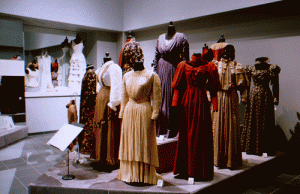April 14 – December 16, 2000
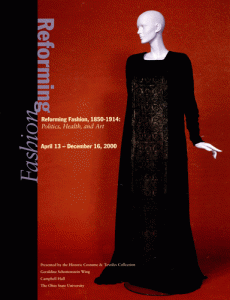
View the exhibition catalog (pdf).
View images from this exhibition.
“Strive as you will to elevate woman, nevertheless the disabilities and degradation of her dress, together with that large group of false views of the uses of her being and of her relations to man, symbolized and perpetuated by her dress, will make your striving vain.”
-Gerritt Smith
Reforming Fashion, 1850-1914 is about the women’s dress reform movement of the late 19th and early 20th century. Fashionable dress in the 19th century went through several silhouette changes from tubular to hourglass and back to tubular. The fashion of the dress silhouette was not dependent on the natural human body but rather on a range of undergarments including chemise, petticoats, hoops, bustles, and corsets to create an artificial shape. A growing number of people including feminists, health advocates, physicians, artists, and educators began to believe that women’s clothing, particularly fashionable dress, was harmful to women’s health.
Solutions promoted by the dress reformers included trousers, reform underwear, and artistic dress. The reformers had a lasting impression on dress as trousers were adopted by sports enthusiasts and became part of the archetypal gymnasium suit worn at colleges and high schools. Reform styles eventually became fashionable dress as artistic reformers created more comfortable gowns with empire waists and soft drapable fabrics.
- The Trouble with Fashion
- Ladies in Trousers
- Reform Underwear
- Artistic Dress
- The Impact of Dress Reform on Fashion
The Trouble with Fashion: Getting Dressed in the 1880s
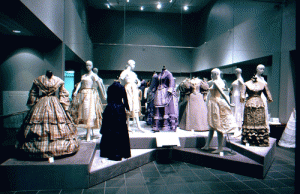
“Trouble with Fashion” display as part of the Reforming Fashion exhibition in the Snowden Gallery. This display showcases various dresses with their “X-ray” counterparts to show the undergarments needed to achieve the various fashionable silhouettes.
Problems with fashion were evident throughout the nineteenth century. The fashionable woman reshaped her body not with diet and exercise, but with many layers of undergarments, a built-up structure that then supported and created what became the correct and ideal silhouette for her gown. The process of getting dressed of 1885 was a time consuming ritual. Women did not just jump out of bed, throw on a bra, slip, panty hose, pumps and a comfortable knit dress before dashing out the door.
When getting dressed, the fashionable woman first put on her stockings, which were gartered above the knee with elastic bands that could reduce circulation of the legs. She might then put on her high cut button shoes because, once the corset was on, it then became difficult to bend down to button the shoes. The next two pieces were drawers and chemise. Drawers were knee-length or longer cotton trousers that buttoned at the waist, often left open for ease in elimination. Over the drawers she put on either a hip-length knitted vest and a short petticoat or a chemise. The next essential garment was the corset stiffened with thin strips of whale bone. If a woman tight laced she risked squeezing her intestines and internal organs. Her breathing would be restricted as well. Over this, a woman put on a corset cover and then a bustle, a contraption made of coils that was tied around the waist and hung in back. Another petticoat would be worn over this.
Finally, the fashionable woman would put on her gown, which might consist of a boned bodice and stiffened skirt to match. Strings or elastic might be attached inside the skirt to keep the back fullness and the bustle in place. If it were cold, the fashionable woman might wear a jacket decorated with jet beads, which could add as much as ten pounds to her clothing. In all, her complete outfit could weigh as much as 25 pounds.
Ladies in Trousers
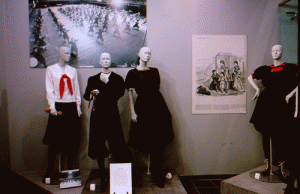 Examples of trousers for women in appropriate conditions, such as cycling and gymnasium sport activities.
Examples of trousers for women in appropriate conditions, such as cycling and gymnasium sport activities.One of the first elements of fashionable dress to come under the reformers’ fire was the long full skirt. Long skirts dragged on the ground, sweeping up tiny vermin and debris from the street with the wearer’s every step, to be then deposited indoors. Petticoats hung heavily on the waist, cage crinolines could swing out and flip up in the wind, trains and bustles were heavy and awkwardly balanced. Women’s skirts made walking up and down stairs treacherous and running nearly impossible.
The reformers chose a solution which they believed was both practical and modest. They did not elect to reveal women’s legs for that would have been improper, indeed, unthinkable. Rather, they chose to wear a dress made like other fashionable dresses except for its knee-length skirt worn over matching trousers. A similar style was worn by Turkish and Syrian women and had been worn on stage and for masquerade dress. Trousers, called pantalets, had also been worn under skirts by women in France in the early 1800s, and later became the fashion for young girls. Pantalets were seen on gymnasium outfits as early as 1830. Trousers also were worn by women in sanitariums and in communal societies.
Although fairly restricted in use, trousers caught the attention of a young feminist, Elizabeth Smith Miller. She adopted the costume for her own everyday dress and introduced it to her cousin, Elizabeth Cady Stanton, and Stanton’s friend, Amelia Bloomer, editor of The Lily, a feminist tract devoted to temperance and women’s reform. Bloomer began wearing the shortened skirt and trousers in 1851, the advantages of which she described in a Lily article. The local newspaper in Seneca Falls, NY, The Courier, also commented favorably on the style worn by Mrs. Bloomer, and soon newspapers picked up the account and named the style, the “bloomer”. Although coverage was widespread, Amelia Bloomer observed that “some of our editorial brethren” commend us highly, while others cry out against this “usurpation of the rights of man.”
In the 1850s commendations of the bloomer costume were indeed widespread; women in Europe–Britain and Germany– adopted a similar costume. Supporters in America noted the practicality and convenience of the new costume, as well as its health benefits. They saw moral and patriotic qualities in its simplicity. On the other hand, opponents have strong arguments for rejecting the bloomer. Some simply believed that it was bad fashion, or immoral or unpatriotic because it was based on foreign styles (Middle Eastern). Perhaps the strongest argument used was the belief that the bloomer was incongruous with prevailing ideology regarding women’s roles. There was strong antagonism towards women wearing trousers, and those who wore the bloomer in public faced harassment. Numerous cartoons played upon deep-seated fears of people regarding gender and fashion.
Eventually, bloomers became associated with the women’s rights movement, an effort not wholly embraced by Americans. Indeed, feminists shared Elizabeth Cady Stanton’s opinion that woman’s dress perfectly described her condition: “her tight waist and long trailing skirts deprive her of all freedom.” Yet notwithstanding the recommendations given in The Lily, many feminists ceased wearing the bloomer after a few years. They believed that the ridicule became counter productive to gaining rights for women. When asked why she returned to fashionable dress, Amelia Bloomer noted the new cage crinoline greatly relieved the heavy weight of the petticoats, and as a newcomer in Iowa, she needed to be sensitive to local fashion.
Some women activists continued to wear trousers and did not stop their promotion that the trousers were better for women for health reasons. Those that advocated bloomers for health implied a weakness to women which was then not met with as much criticism. The mid-nineteenth century saw a huge increase in the interest of exercise which further linker the trousers to the health of women and made it acceptable for a variety of sports and outdoor activities, such as mountain climbing, swimming, and bicycling. This continued through the early twentieth century. Trousers may not have been readily accepted as fashionable dress, however, they were accepted for physical activities such as bathing, bicycling, and gymnastics.
Reform Underwear
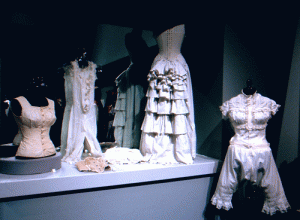
Ivory cotton twill “equipose” corset/underbodice with no bones, c. 1880-1884. Kent State University Museum.
Many of the objections to fashionable dress were in fact directly related to abuses caused by undergarments. Remember that the fashionable woman of the 1880s wore too much underwear; it restricted her and weighed her down. It could be too hot in the summer and not warm enough in the winter. (Even the cage crinoline, that mercifully reduced the number of petticoats, allowed air to blow around a woman’s legs). The corset was generally worn too tight. The many skirt layers created bulk at the waist and the weight of the clothing was unevenly distributed. If the excess bulk were removed, then a woman would not have to resort to tight-lacing which, according to many health experts, greatly damaged women’s internal organs and caused disease.
One of the first reform undergarments to be promoted in America was the “emancipation union under flannel” patented in 1868. This union suit combined a knit flannel waist (shirt) and drawers in one. The combination, as the union suit was often called, was continuously improved by various knitwear companies and reformers in America. Susan Taylor Converse of Woburn, Massachusetts, designed an improved version in 1875 and named it the Emancipation Suit. A gathered section across the bodice freed the breasts from compression, and sets of buttons at the waist and hips helped suspend several layers of skirts. The Emancipation Suit also could have been purchased as two separate parts that buttoned together at the hips.
The Emancipation Suit was endorsed by the New England Women’s Club, one of the earliest organizations to advocate undergarment reform. In 1873 their dress-reform committee, headed by Abba Goold Woolson, sponsored a series of lectures on the hazards of fashionable dress by four eminent female physicians. These lectures were later published in 1874 under the title, “Dress Reform.”
One of the best known reformers of underwear was the German-born Dr. Gustav Jaeger, who published a book on rational dress titled in 1880 “Die Normalkleidung” (Rational Clothing). Jaeger’s knit union suits were particularly popular with reformers in England after they were featured at the International Health Exhibition in 1884. This Kensington exhibition included a section on hygienic dress and featured noted architect and theatrical designer Edward Godwin as a speaker on dress reform.
Dress Systems
Several individuals devoted to reform devised whole systems of underclothing that included no corset at all. In the 1890s, one of America’s best known health reformers, Dr. J. H. Kellogg, developed a dress system at the Battle Creek Sanitarium which was “practical, healthful and artistic”. Kellogg stated that “any young woman who has not permanently ruined her body by badly constructed apparel can in a short time learn to stand like the Venus Genetrix”. His dress system attempted to minimize the weight on the hips and shoulders previously emphasized in fashion. Corsets and tight bodices were discarded. Through the sanitarium women could order patterns or ‘garments made in the Dress Department’. The general plan for the dress system included designs for gowns and undergarments. For the latter, women could choose from the following selections to best suit their needs for warmth and comfort: the union suit, jersey tights (worn over the union suit for extra warmth), a combination suit (instead of chemise and drawers), the Dr. Lindsay divided skirt (knitted for warmth), the improved divided skirt (without visible divide), skirt waists (to be sewn or buttoned to skirts), the improved Freedom waist (with two rows of buttons for attaching the dress skirt and petticoat or drawers, or umbrella drawers (a yoked skirt, divided skirt, and ruffled drawers with yoke).
Annie Jenness Miller, a frequent lecturer, author, and publisher on the subject of physical culture and correct dress, also devised a dress system to replace the fashionable chemise and drawers, corset, corset cover, and petticoats. As illustrated in her journal, Dress, the Jenness Miller Magazine, this system was similar to Kellogg’s and included, leglettes and chemilettes, to replace petticoats, and a model bodice, to replace the corset.. The Jenness-Miller system also included a bosom support for stout women, a garment similar to a brassiere.
Although not a separate undergarment, the gown form provided by both Kellogg and Jenness-Miller was essential as a foundation for the outer dress. The gown form cut in the princess style not only replaced the lining of a fashionable skirt, but was so arranged “that graceful drapery [could] be formed upon it, and the weight evenly supported” by the body. It also eliminated tie backs around the legs and had no band at the waist. Patterns for the both systems could be purchased from the publisher or from various dress reform outlets across the country.
The new reform underwear systems of Kellogg, Jenness-Miller and others were meant to distribute the weight of clothing, eliminate the heavily boned corset, and reduce excessive bulk and weight. These undergarments could be worn without being readily noticed and were a great improvement over the more fashionable, but distorting undergarment.
Artistic Dress
In order to make visible the damaging effects of the corset many authors of dress reform literature showed the statue of Venus de Milo, the epitome of natural beauty, contrasted with the distorted body of a corseted woman. However, it was the proponents of artistic dress who most heartily adhered to classical ideals of beauty reflected in the Venus statue. They applied the principles of art, upon which these ideals were founded, to dress. For them the artificiality of fashionable dress “the corset, crinoline, bustle, and other disguising elements of fashion” went against nature and thus destroyed the beauty of a woman’s natural form.
Among the earliest aesthetic dress reformers were those associated with the English Pre-Raphaelite painters. As the Pre-Raphaelites and their devotees gained recognition in the 1860s and 1870s, the public had opportunity to see historic and aesthetic dress in paintings and on women who attended exhibitions at the Royal Academy and the Grosvenor Gallery in London. Many of the fabrics for artistic dress were supplied by Liberty’s, the shop on Regent Street which had been established in 1875 by Arthur Lasenby Liberty as the East India Shop. Specializing in the silks most suitable to clinging robes and draperies worn by the artistic community, Liberty’s introduced delicate pastel tints which they called ‘Art Colors’ to dye imported silks.
In 1884 Arthur Lasenby Liberty asked reformer Edward Godwin to direct the dress department in the Liberty store, making artistic dresses readily available. In its catalogs the Liberty Company offered artistic dresses which were modified to follow the conventions of modern life, but shared design elements with classical Greek clothing as reinterpreted during the Empire and Renaissance periods. The Liberty gowns were given appropriate names such as “Jacqueline”, a velvet and silk crepe gown fashioned after a French fifteenth-century gown for indoor use, or “Josephine”, an Empire-style (high-waisted) evening dress and they worked well with Liberty’s soft and very drapable fabrics. Liberty gowns were well publicized and available in their own Paris shop and other stores throughout Europe as well as New York.
Artistic Dress in Germany and Austria
Reformers in the British Arts and Crafts movement greatly influenced artists, architects, and designers in Germany and Austria where, not surprisingly, the modern design movement of the 1890s and early 1900s included artistic reform of women’s dress. Henry van de Velde, who advanced the art nouveau style, also supported artistic reform in women’s dress throughout the continent, especially in Germany. Not only did he write about reform dress, but he designed dresses as well. In support of a new artistic dress, Van de Velde observed that architects had finally realized that women’s dress must correspond with modern interior design and architecture as a new decorative idea that immediately makes it “a piece of art.” He further suggested that clothing should express a women’s individuality, the exception being street wear, which would be dictated by place or appropriateness; clothing should be fit to purpose and adapt to private, general, or ceremonial spheres. In April 1900, a successful exhibition in Krefeld, Germany, which included Van de Velde’s artistic dress designs generated exhibitions of artist-designed reform dress in other cities as well, including Dresden. Leipzig, Wiesbaden and Berlin. The Wiener Werkstatte director, Koloman Moser, created reform styles for his wife that were high-waisted and full. Anna Muthesius also preferred the full, high waist style. Muthesius was an opera star and author of a book on dress reform, The Personal Dress of Women (1903).
Reform styles promoted in the Austrian fashion magazine, Wiener Mode, in 1903 included the princess and Empire style, as well as full gowns with a high waist, similar to a “Mother Hubbard” style. They could be for weddings, tea, society, or house work.
Artistic Dress in America
Aesthetic dress in America was greatly influenced by the British aesthetic movement. Ideas regarding artistic styles were rapidly dispersed through various print media. Rather than being solely confined to elite circles of artists, artistic dress appeared to have a middle-class following. Indeed, American magazines did not miss the opportunity to report an aesthetic dress. An 1878 issue of the American Agriculturist observed that the aim of the Pre-Raphaelite style was to “have a thick waist”, like the Venus de Medici and Venus of Milo. Furthermore, it reported that artists declared tight waists unartistic and vulgar because the natural beauty of the human figure is lost through the destruction of its healthy proportions.
Annie Jenness Miller, publisher of Dress, the Jenness Miller Magazine (1887-1898), was an outspoken advocate of artistic reform in women’s dress, stressing the need to adapt artistic principles to life and to dress in order to achieve beauty through simplicity, unity, utility, and harmony. The magazine frequently featured examples of artistic dress, patterns for which were available for purchase from the Jenness-Miller Publishing Company.
Outside of artistic circles, the artistic reform styles most acceptable to fashionable American women were wrappers, or house gowns, especially the more formal version, the tea gown, which gained popularity in the 1870s. Taking the lead of the British, Americans designed tea gowns in a vaguely medieval or classical style that appeared to be loose fitting. Etiquette demanded that they be worn only in the home where they were appropriate when entertaining close friends. However, as noted in the Jenness Miller Magazine, women of the 1890s frequently wore tea gowns in public, especially at summer resorts.
The Impact of Dress Reform on Fashion
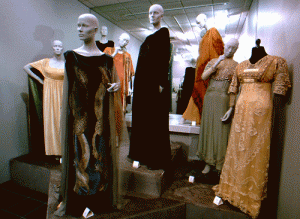
Clearly, all efforts toward reforming dress had a lasting influence. The loose, Turkish-style trousers worn for the exercises became part of the archetypal gymnasium suit worn at colleges and high schools well into the mid twentieth century. And trousers remained quite acceptable and appropriate for hiking, biking, and many other recreational activities as well. The loose full trouser style occasionally sees revival as fashion today. Reform underwear–knit union suits, shirts and drawers–continued to be offered by stores and mail order catalogs. The drop seat union suit still provides a warm under layer for skiing and other winter sports.Reform styles as fashion was not a novelty on the continent of Europe. Wertheim’s Department Store in Berlin had a dress reform department, which was run by 1903. And as early as 1901, a fashion magazine published in Vienna, Wiener Mode, illustrated various reform style gowns along with more fashionable dress. They clearly drew on the language of the artistic reformers, calling these dresses the “new style”, “Empire Style” or “Empire Reform Style”.It is clear that even before 1909 the idea that women could wear loose-fitting artistically inspired clothing in public was a reality. Women not only became accustomed to wearing more comfortable clothing in their homes and during physical activities, but they also began seeing actresses, dancers, and opera singers wearing simpler artistically designed dresses on stage and in public. These entertainers sought out two of the most celebrated avant-garde designers in the early twentieth century, Paul Poiret and Mariano Fortuny.These designers were acquainted with the gowns created by the German and Viennese artists and architects, as well as the artistic reform dress promoted by the Liberty Company. Fortuny’s Delphos dresses and Poiret’s Directoire models offered to the public in 1907 were similar to other artistic styles inspired by the Greek ideal. While these two men are often credited with freeing women from corsets, they were not the innovators. Rather, they were simply nourishing the seed that had been planted by the artistic dress reformers of the nineteenth and early twentieth centuries.The Empire, high-waisted, silhouette was dominant between 1909 and 1915. Gowns were often constructed of layers of soft, drapable and sometimes transparent silk fabrics, not unlike those imported and manufactured by the Liberty Co. in London. Other couture designers whose gowns reflect the reform style include Jacques Doucet and Lucille, and in the teens Vionnet and Chanel.

